
What impact will climate change have on biological control communities?
That’s the question Jessica Sparkes, a Master’s student at the
University of Windsor, is helping tackle with her research project at
the Greenhouse and Processing Crops Research Centre at Harrow, Ont.
What impact will climate change have on biological control communities?
That’s the question Jessica Sparkes, a Master’s student at the University of Windsor, is helping tackle with her research project at the Greenhouse and Processing Crops Research Centre at Harrow, Ont.
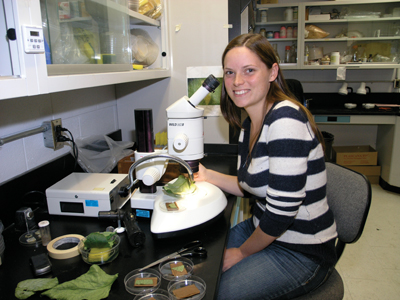 |
|
| University of Windsor Master’s student Jessica Sparkes is part of a biocontrol and climate change project.
|
The work is part of a three-year Natural Sciences and Engineering Research Council of Canada (NSERC) project – “Ecosystem response to perturbation at multiple spatial scales” – headed by Dr. Sherah VanLaerhoven of the Biological Sciences Department at the University of Windsor. Dr. VanLaerhoven is working with researchers with Agriculture and Agri-Food Canada and the universities of Montreal, Laval and Simon Fraser, along with some growers in Ontario and Quebec.
Among AAFC scientists involved with the project is Dr. Les Shipp of the GPCRC.
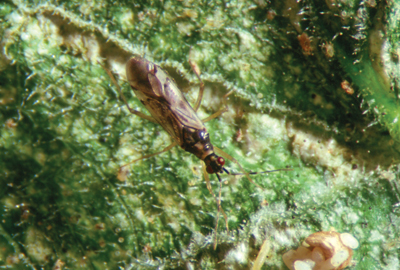 |
|
| Dicyphus hesperus
|
“The grant is looking at climate change, and its impact on biological control communities – the plants, the pests, and the natural control agents – and how they all interact,” explains Shipp.
The greenhouse was chosen as a model system because of the controls that can be put in place.
Sparkes is focusing on whiteflies as the pest, and the predator Dicyphus hesperus. Dicyphus is an omnivore, meaning it will feed on the plants as well as its prey. It’s also a generalist predator, feeding on thrips and spider mites.
“Dicyphus requires both the plant and the prey for its survival,” says Sparkes. That makes it quite unique among predators.
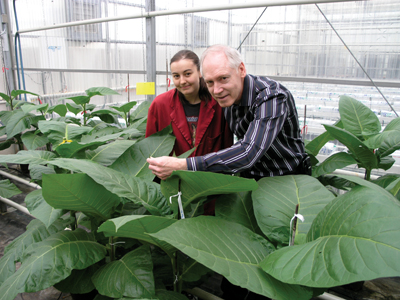 |
|
| Domestic production of Eretmocerus may soon be possible, thanks to work by Nicole Stewart of Crop Defenders, and Dr. Les Shipp of the GPCRC.
|
She’s looking at temperature fluctuation, and specifically the amplitude – the high and low temperatures over a short period of time – and how those fluctuations will impact the behaviors of Dicyphus.
So far, she’s looked at the predation rates. The research will now focus on intra-guild predation. What happens if another predator is introduced – in this case, Encarsia formosa? How will Dicyphus react? “Will the fluctuations in the temperature have any effect on whether it feeds on whitefly or Encarsia?”
Will it choose to feed on Encarsia, something with higher nutritional value, when typically it would choose whitefly, which is easier to feed on?
The more information you have on biocontrols, the more success you will have, Shipp explains.
Dicyphus isn’t used as a biocontrol agent much any more, but it’s a good model system. It’s quite similar to Macrolophus in Europe. “It’s a good modeling system for most generalist predators,” he says.
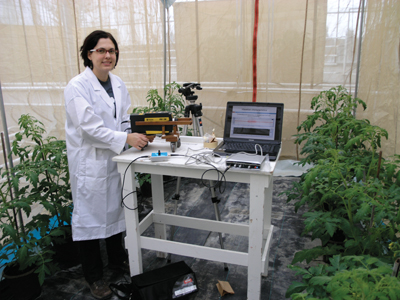 |
|
| Patricia Nunes Silva is studying the frequency and velocity of the vibrations, along with the thoracic displacement, of a bee during pollination.
|
Dicyphus was chosen because a lot is already known about it and has been subject to considerable research.
“It might mean we could return to using it as a commercial biocontrol agent,” says Shipp, “especially if we go more to supplemental lighting in greenhouse crops.” Dicyphus goes into reproductive diapause under low light conditions.
For example, Quebec growers who utilized supplemental lighting used Dicyphus for whitefly control.
THE LATEST BUZZ ON BEES
Greenhouse tomato growers in Brazil currently don’t use bees to pollinate their crops, and it has resulted in reduced yields.
Patricia Nunes Silva is hoping to change that. She’s a PhD student from the University of São Paulo in Brazil who’s currently at the GPCRC studying bee pollination.
Shipp is helping supervise her work, along with Dr. Peter Kevan from the University of Guelph. Kevan is the Science Director for the NSERC-CANPOLIN Network, which looks at various pollination issues with native and managed pollinators in Canada.
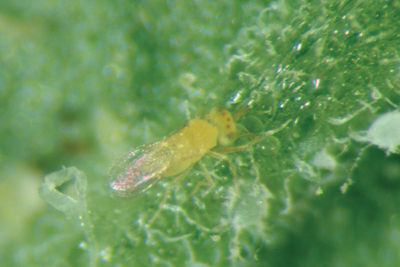 |
|
| Eretmocerus has certain advantages over Encarsia, certainly in the winter months when it is a much more active searcher with a higher parasitism level.
|
Canadian growers have been using bumblebees for pollination since the early 1990s.
“We’re beginning to raise bees to become pollinators of greenhouse crops,” says Silva. She came to the GPCRC to study “what makes bumblebees good pollinators.”
She will then compare those findings with her work on stingless bees in Brazil. There are some around 500 species of stingless bees in Brazil, and only two have been tested for tomato pollination efficacy.
Specifically, she’s studying the frequency and velocity of the bee vibrations, along with the thoracic displacement of a pollinating bee during pollination.
“Most growers in Brazil don’t have pollination programs,” she explains. She hopes her work will encourage more growers there to consider it.
Shipp says her work is also important for Canadian growers. “This will broaden our knowledge of pollination efficiency of bumblebees in greenhouse crops, to better understand how it works and how we can improve it.”
MORE HOMEGROWN PREDATORS
Many years ago, the Harrow research station was the first to successfully commercially raise Encarsia in North America.
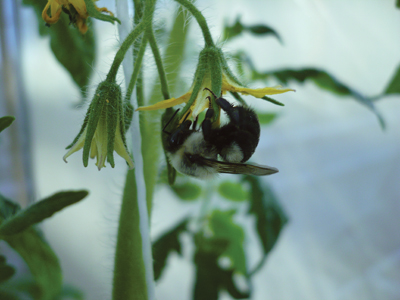 |
|
| A bumblebee pollinating a tomato flower.
|
Today, the Centre is continuing that legacy with research now underway to develop protocols to mass-produce Eretmocerus eremicus in Canada. Currently, Eretmocerus is imported from Europe.
Shipp is working with Crop Defenders Ltd. of Leamington on the project. Representing the company in the study is Nicole Stewart.
Encarsia is now used against whitefly. However, Eretmocerus has certain advantages over Encarsia in the winter months when it is a much more active predator with a higher parasitism level.
The imported predators are working quite effectively, notes Shipp. Crop Defenders is only looking to provide a local source for growers.
Tobacco plants are a good whitefly host and will be used in the rearing process. “It’s an easy crop to grow,” explains Shipp, “and it has very large leaves.”
The plants will be exposed to whitefly, which will go through their various life stages. Eretmocerus is then introduced, and the resulting parasitized scales are then collected for distribution to growers. “The biggest challenge is in raising a large enough number to ensure a continual supply in sufficient amounts.” ■
Print this page